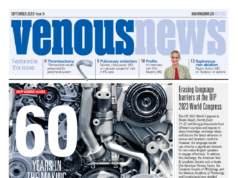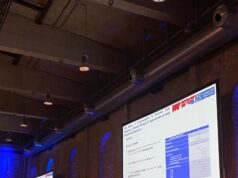
A study into the efficacy of early reflux elimination for venous leg ulcer (VLU) patients has revealed that the combination of ultrasound-guided foam sclerotherapy (UGFS) only, and a hybrid method of endovenous laser treatment (EVLT) with UGFS, could present a minimally invasive method of treating superficial venous reflux.
Aleksandra Jaworucka-Kaczorowska (Gorzów Wielkopolski, Poland) presented the results of the study at the European Venous Forum (EVF; 27–29 June, Zurich, Switzerland), outlining how both the UGFS-only and hybrid methods can be associated with high healing rates and low mid-term recurrence rates. In addition, both approaches may prove more cost-effective and popular by replacing life-long compression therapy with a single intervention.
While compression therapy is still the “mainstay of treatment” for VLU patients, Jaworucka-Kaczorowska emphasised that “more than 85% have superficial venous reflux and are therefore candidates for intervention”. In response to the findings of the ESCHAR and EVRA trials, the elimination of axial and perforating reflux has been suggested as an adjunctive therapy for reducing recurrence rates and accelerating healing.
In order to assess the efficacy of early reflux elimination, the study aimed to determine ulcer healing rate at 24 weeks and one year, as well as ulcer recurrence rate at one year, after the elimination of axial and perforator reflux in patients with active VLU. All of the participants, 69% of whom had first-time ulcers, were also treated with compression therapy as part of the study.
Prior to the beginning of treatment, and one, three, six and 12 months afterwards, each participant underwent a clinical assessment to measure ulcer dimensions and the wound at risk of infection (W.A.R) score, and a duplex assessment to determine the condition of deep and superficial veins, the presence of reflux and any post-treatment venous occlusion.
Explaining the findings of the duplex assessment, Jaworucka-Kaczorowska said: “I found perforating vein incompetency in 63% of patients and segmental deep vein incompetency in almost 16% of patients. Also, 61% of segmental deep vein reflux disappeared after ablation of the incompetent superficial veins.”
Following the first clinical and duplex assessment, patients received one of three treatments: UGFS of the incompetent superficial veins, perforating veins and tributaries (34.2%); UGFS of the incompetent perforating veins and tributaries (35%); or a hybrid method of both UGFS and EVLT (30.8%). All patients underwent pharmacotherapy and a wound care strategy of surgical debridement, antiseptic and wound dressing in addition to their treatment.
The results of the trial showed an ulcer healing rate at 24 weeks of 92%, which rose to more than 98% after one year with only two leg ulcer patients failing to heal, and a median VLU healing time of 3.4 months. Furthermore, the estimated one-year recurrence rate was just 4.4%. “I also assessed the time of healing according to ulcer area, and the bigger it was at the beginning the longer it took to heal” added Jaworucka-Kaczorowska. Similar results were also recorded in terms of ulcer duration, with those that newer wounds taking less time to heal.
100% of patients with isolated superficial reflux healed in three or less months, while the presence of incompetent perforating veins prolonged the healing time; 50% of patients with additional perforating vein incompetence healed in more than three months. Patients with isolated perforating vein incompetence demonstrated the lowest healing rate, as none healed in less than six months.
“UGFS and hybrid approaches appear to be attractive, minimally invasive methods of treating superficial venous reflux. Since long-term patient compliance to compression is relatively poor, it may prove more effective as well as cost-efficient to provide a single intervention to reduce recurrence, rather than life-long treatment with compression,” Jaworucka-Kaczorowska concluded.











